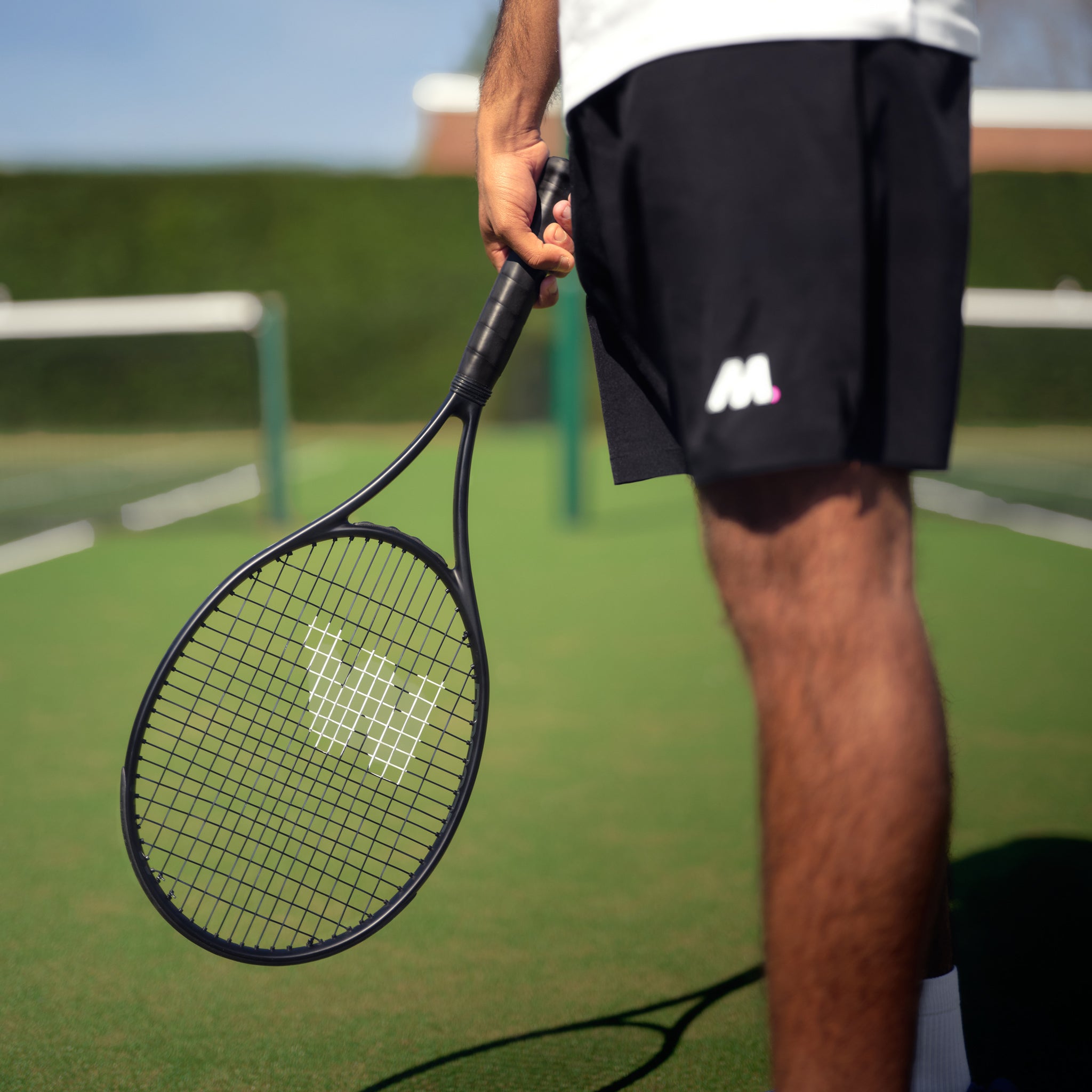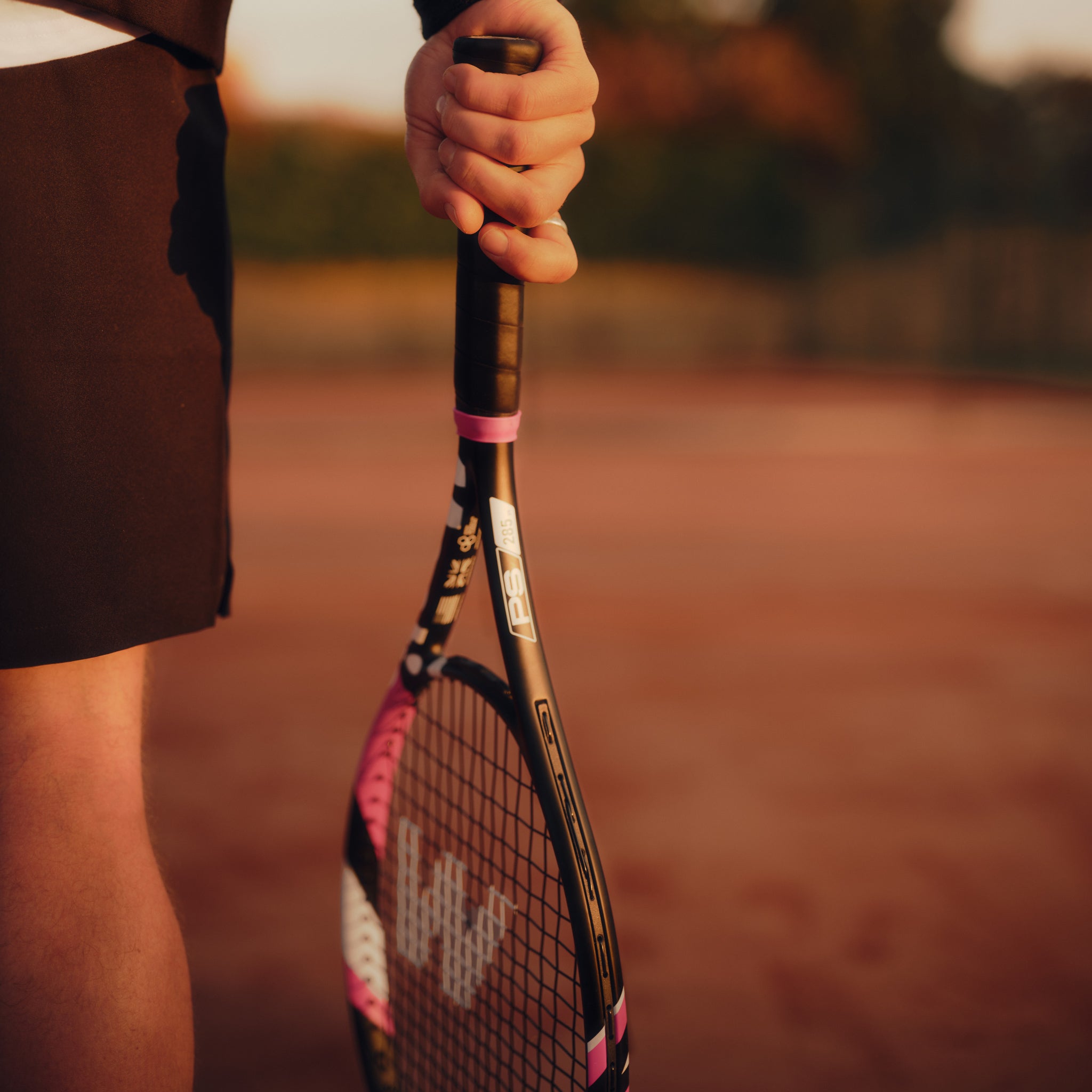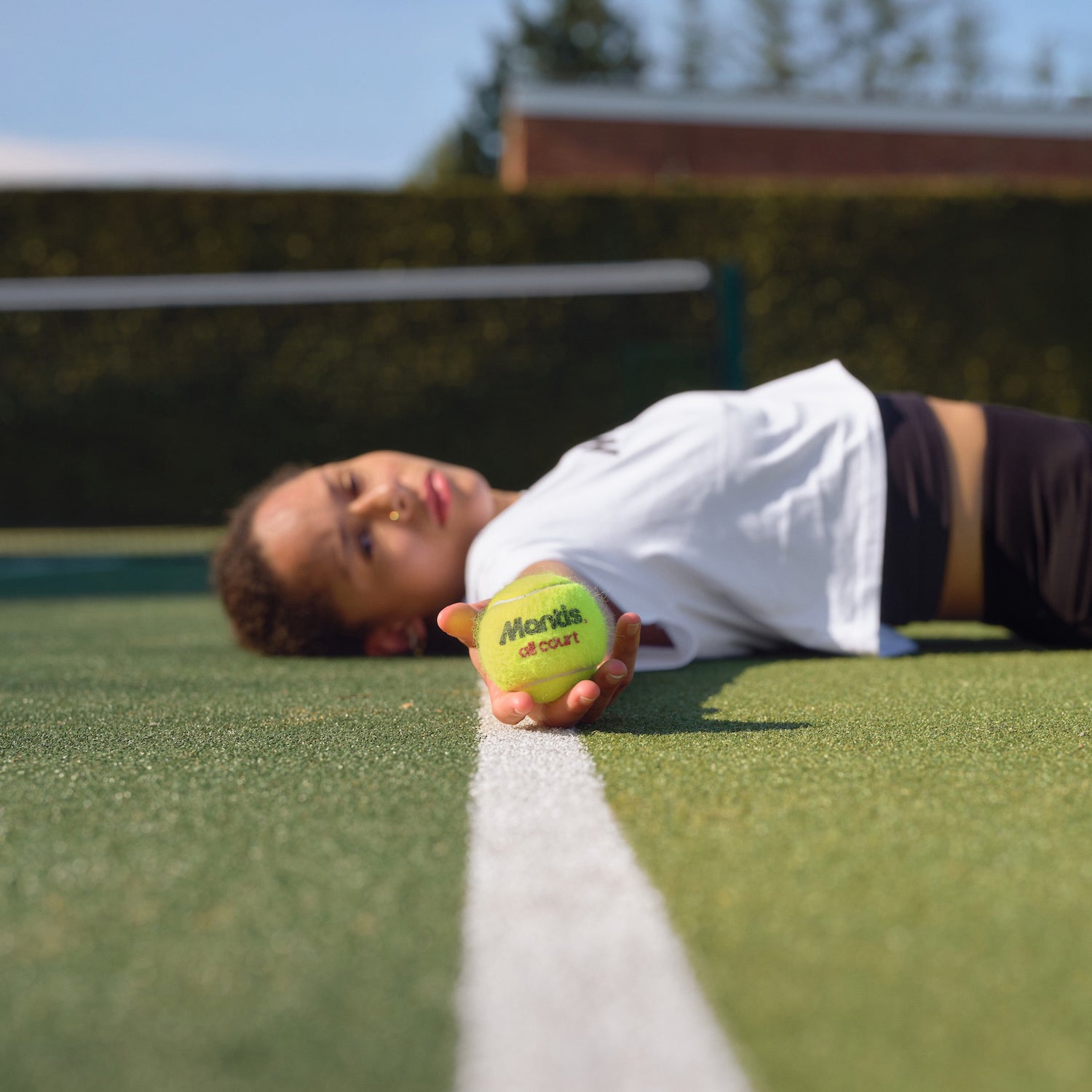
Choosing the right beginner tennis racket is easily the most important decision you'll make when you first pick up the sport. A good starter racket, like those we design at Mantis, feels like a natural extension of your arm, making it forgiving, easy to swing, and powerful enough to help you learn without getting in your way.
Finding a Beginner Tennis Racket for Your First Day on Court
Starting your tennis journey is an exciting moment, but we know the world of rackets can feel overwhelmingly technical. Our goal here is to cut through the jargon and walk you through the handful of features that truly matter for a new player. At Mantis, our entire focus is on performance-driven gear, and our guide on how to choose a tennis racket offers an even deeper dive for when you're ready.
You’re not alone in this search, either. Tennis is seeing a huge surge in popularity, especially among recreational players. In fact, the tennis equipment market in the United Kingdom was valued at £118 million in 2022 and is projected to keep growing. This growth is driven by people just like you, picking up a racket for the first time.
The Big Three: What Really Matters in a Beginner Racket
To find the perfect match, you only need to understand three core elements. Think of these as the building blocks of a great racket that will support your game as it develops.
We'll focus on the most important factors for any newcomer:
- Head Size: This affects the size of your hitting area, or "sweet spot."
- Weight & Balance: These determine how easy the racket is to swing and control.
- Grip Size: Getting the right fit is crucial for both comfort and preventing injury.
By the end of this guide, you’ll have the confidence to choose a racket that doesn't just suit your current skill level, but helps you grow. The right gear makes those first few hours on court fun, rewarding, and the start of a lifelong passion.
Let's break down each of these components so you know exactly what to look for.
Why a Bigger Head Means a Bigger Sweet Spot
When you're just starting out in tennis, if there's one racket feature to focus on, it's the head size. Think of the racket's head as your hitting zone; for anyone new to the game, a bigger target is always your best friend. At Mantis, we consistently point new players toward rackets with a more generous head size, which you'll find throughout our collection of Mantis tennis rackets.
A larger head—typically anything over 100 square inches—gives you a huge advantage by creating a bigger “sweet spot.” This is the prime real estate on your string bed, the area that delivers the most power and the best feel with the least amount of jarring vibration.
The Trampoline Effect
Picture the string bed as a small trampoline. The very centre is where you get the most spring, the highest jump for the least amount of effort. The sweet spot on a racket works in exactly the same way. When you connect with the ball right there, the shot feels clean, crisp, and powerful.
Of course, as a beginner, hitting the ball perfectly in the centre every single time is a tall order. A larger head size simply expands this effective hitting area, making the racket far more forgiving on off-centre shots.
A bigger sweet spot means that even when your timing is slightly off—which happens all the time while you're learning—the racket still sends the ball back with decent pace and stability. This forgiveness is absolutely crucial for building confidence and making the game more fun from day one.
Generating Power, Effortlessly
The other major plus of a larger head size is how it helps you generate power without having to over-swing. That trampoline effect isn't just about forgiveness; the strings on a bigger racket head can stretch back more on impact, creating a catapult-like launch that sends the ball flying.
This built-in power helps in a few important ways:
- You conserve energy. You won’t get tired as quickly, which means you can have longer, more productive practice sessions.
- It encourages better technique. You can focus on developing a smooth, controlled swing instead of trying to muscle the ball over the net.
- It reduces strain. Less brute force on every shot lowers the risk of developing arm fatigue or even an injury.
For any player still developing their strokes, this effortless power is a game-changer. It frees you up to concentrate on your form and consistency, trusting that the racket itself will provide the pop you need.
How Racket Weight and Balance Affect Your Swing

This simple infographic neatly ties together the core features of a beginner's racket—weight, head size, and tension—with the results you'll feel on court: power, control, and manoeuvrability. It’s a great visual reminder of how these elements must work in harmony to create an effective tennis racket for a beginner.
Once you’ve settled on a head size, the next crucial piece of the puzzle is the racket’s weight. When we at Mantis help new players, we almost always start by looking at lighter frames. For anyone just starting out, we suggest sticking to rackets under the 300-gram mark (that’s unstrung weight).
A lighter racket is simply much easier to swing. This allows you to generate racket-head speed without straining, helping you build a smooth, proper technique right from your first hit. Just as importantly, it helps keep fatigue at bay and lowers the risk of common overuse injuries like tennis elbow.
Finding the Right Balance Point
But weight is only half the story; the other is balance. This is all about where that weight is distributed along the frame. A great way to think about it is holding a hammer: grip it by the end of the handle, and the head feels heavy and powerful. Choke up closer to the head, and it suddenly feels much lighter and easier to control.
Rackets are categorised in a very similar way:
- Head-Heavy: More of the mass is in the racket's head. This gives you extra stability and a bit more "oomph" on your shots, letting the racket do more of the work.
- Head-Light: More mass is concentrated in the handle. This makes the racket feel quicker and more manoeuvrable, a favourite of advanced players who generate their own power.
- Evenly Balanced: The weight is spread out uniformly, striking a nice middle ground between power and control.
For a new player, a racket that is either head-heavy or evenly balanced is almost always the best choice. That extra weight in the head helps stabilise the frame when you make contact with the ball, so even your off-centre hits will feel more solid and less jarring.
This stability is incredibly confidence-inspiring, making it far easier to learn the fundamentals. It lets you focus on your swing, knowing the racket will provide the stability and power you need to get the ball over the net consistently.
Finding Your Perfect Grip Size and Racket Material
While head size and weight tend to get all the attention, there’s a crucial detail that every tennis racket beginner needs to get right: the grip size. Nail this, and you’ll improve your comfort and control while helping to prevent injuries.
To make it easy, we at Mantis have put together a complete walkthrough in our guide on measuring your tennis grip size. The goal is to make the racket feel like a natural extension of your arm.
If your grip is too small, you'll find yourself squeezing the handle just to keep it stable. This leads to tired muscles and can even cause tennis elbow. On the other hand, a grip that's too big makes it tough to move your wrist freely, killing your ability to whip the racket head through for speed or spin. Either way, you'll struggle to control the racket face.
The perfect grip allows you to hold the racket securely with a relaxed hand. This light but firm hold gives you maximum control and feel, letting you direct the ball with precision rather than fighting to control the racket itself.
And while you're focused on the racket's fit, it's also worth understanding your own physical capabilities.
Racket Materials For Beginners
Once you’ve sorted the fit, it’s time to think about what the racket is actually made of. The material plays a huge part in how a racket performs, feels, and, of course, how much it costs. For new players, the choice usually comes down to two main options: Graphite and Aluminium.
- Graphite: This is the go-to material for most modern rackets. It’s light but incredibly strong, offering a fantastic blend of power, control, and comfort by dampening nasty vibrations.
- Aluminium: You'll often find aluminium in more budget-friendly rackets. It's very durable, but it's also heavier and less forgiving than graphite, meaning you'll feel off-centre hits a lot more in your arm.
It’s interesting to note that in the UK, about 60% of first-time players buy their rackets from general sports stores instead of specialist tennis shops. This has really pushed the market towards creating affordable yet capable frames, making lightweight graphite and composite rackets a popular choice for their great value and performance.
Making Your Final Racket Selection with Confidence
Okay, we’ve unpacked the key specs. Now it’s time to put all that knowledge into action and choose a frame with confidence. Think of this as your final checklist, whether you're heading to a local shop or browsing online.
At Mantis, we want you to feel certain about the gear you’re investing in. For an even more detailed breakdown, our guide on how to choose a tennis racket walks you through matching every spec to your personal style of play.
With this foundation, you're well-equipped to find the right tennis racket for a beginner. It’s a great time to be starting, too. The UK makes up a significant 13.32% slice of the European tennis racket market, and as a result, manufacturers are dialling in on features like shock absorption and manoeuvrability—both huge wins for new players.
Your Beginner Racket Checklist
So, what should you look for? To keep things simple, a great beginner's racket almost always nails a combination of three key attributes. Keep an eye out for these specs on any racket you’re considering.
- A Large Head Size: Look for anything over 100 square inches. This gives you a bigger, more forgiving sweet spot, which makes hitting clean shots much easier when you're just starting out.
- A Lightweight Frame: Aim for a racket under 300 grams (unstrung). A lighter frame is easier to swing, helping you generate racket speed without wearing out your arm.
- A Head-Heavy or Even Balance: This balance point adds stability when you make contact with the ball and helps you generate a bit more power without having to swing for the fences.
Don't forget about the string pattern. A more open pattern, like a 16x19, allows the strings to grip the ball more effectively. As you start developing your strokes, this will make it much easier to learn how to generate topspin.
Ultimately, these guidelines are here to point you in the right direction. The perfect choice is the one that feels right in your hand—a racket that makes you excited to get out on the court and just play.
Got Questions About Your First Racket? We Have Answers.
Even with the best advice, picking out your very first racket can leave you with a few lingering questions. That’s completely normal. At Mantis, we’ve found that a confident choice off the court leads to a more confident start on it.
So, let’s clear up some of the most common queries we hear from new players. We want to sort out any last-minute doubts so you can get to the exciting part—actually playing. We'll cover everything you need to know before you browse our collection of Mantis tennis rackets.
How Much Should We Spend on Our First Racket?
You really don’t need to break the bank for your first frame. A great beginner’s racket, usually made from a graphite composite, will typically set you back somewhere in the £50 to £120 range.
Rackets in this sweet spot give you the perfect blend of helpful features—like a forgiving head size and a lighter feel—without the hefty price tag of the high-performance models the pros use. We believe in offering real value, helping new players get into the game without a massive upfront cost.
Does a New Racket Need Restringing Straight Away?
Nope, not at all. Nearly all beginner rackets come pre-strung right out of the box, and those factory strings are more than good enough for learning the ropes.
You can happily play with the factory strings for a few months while you get a feel for the game. Restringing is something you can think about much later, once you start to notice how different string types and tensions might fine-tune your game. For now, it’s not something to worry about.
We're a Smaller Adult. Should We Just Use a Junior Racket?
This is a common question, but the answer is almost always no (However it's worth double checking with a tennis professional). Adults should stick to a full-size (27-inch) racket, even if they’re on the smaller side. Junior rackets are built specifically for the height and developing strength of children, meaning they're too short and light for a grown-up.
Trying to play with a junior frame will likely hold back your technique and seriously limit your power. A much better option for a smaller adult is a lightweight, full-size adult racket with the right grip size. That combination will give you the proper balance of power and control to learn the game effectively and, just as importantly, safely.
At Mantis, we craft performance-driven tennis equipment for players who live for progress. Explore our expertly engineered rackets, balls, and accessories designed with one thing in mind: helping you play your best tennis. Visit us at https://mantissport.com to find the gear that matches your ambition.








